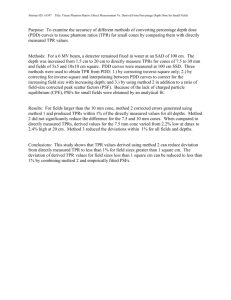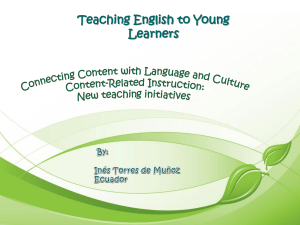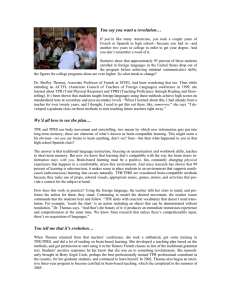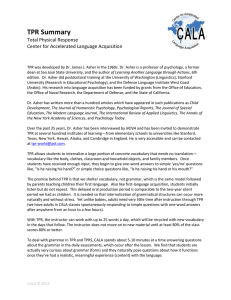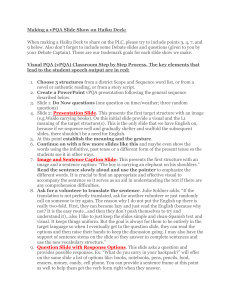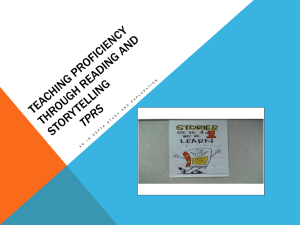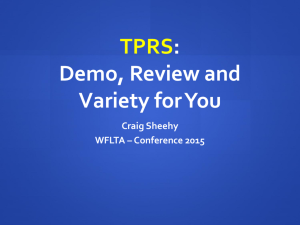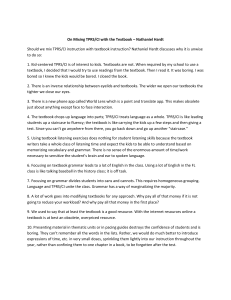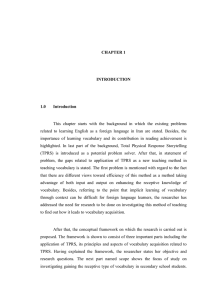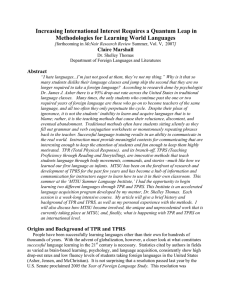Document 10992839
advertisement
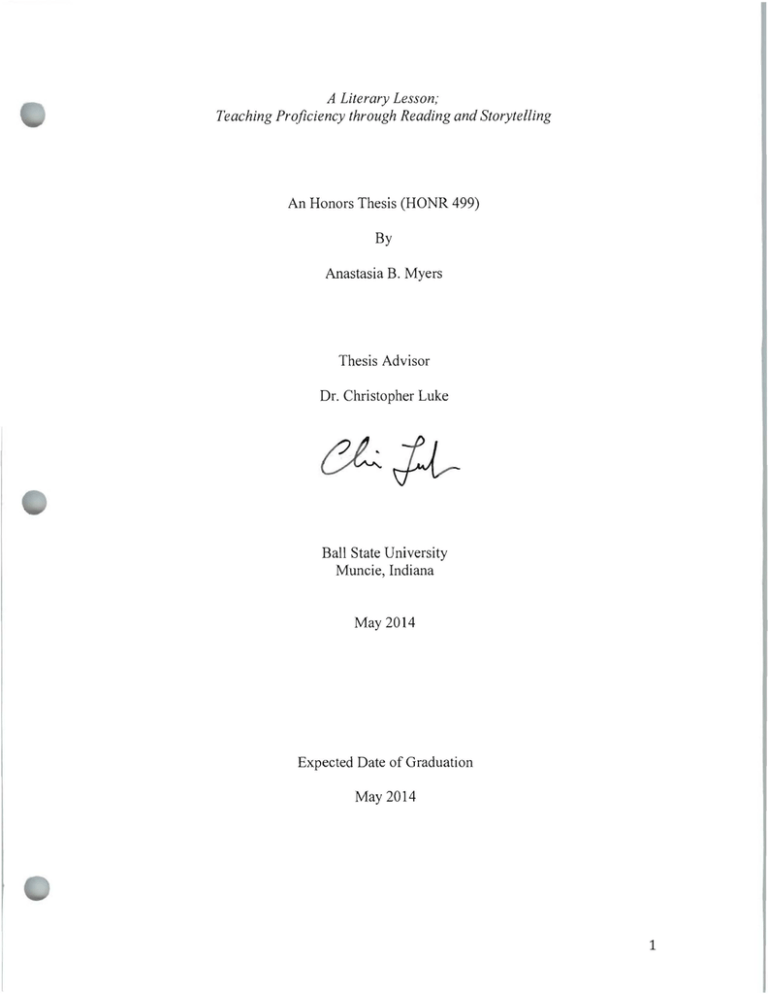
A Literary Lesson; Teaching Proficiency through Reading and Storytelling An Honors Thesis (HONR 499) By Anastasia B. Myers Thesis Advisor Dr. Christopher Luke Ball State University Muncie, Indiana May 2014 Expected Date of Graduation May 2014 1 ~Cdl LA nder,jrild i nes/s I-D 21./8 9 ,Z'i ~Ol if .M. 9J.j Abstract Literature is a driving force in society that influences everyday culture. It can range from simple entertainment to dense in facts but it is consistently educational, especially in a world language classroom. Students can learn vocabulary, verb tenses, grammar, cultural phrases, important aspects of a culture, and more, simply from reading authentic literature. In our own culture, we learn many of these things from reading as well as other forms of communication. TPRS (teaching proficiency through reading and storytelling) is a teaching method that attempts to incorporate the benefits of literature into the learning environment. I use this method to create a lesson plan of the first chapter of a French book that will help students understand culturally and grammatically significant aspects in the future. Acknowledgements I would like to thank Dr. Christopher Luke for his help and support on this project and throughout my collegiate career. His help and expertise have been no small part of my success and motivation to continue as a life-long learner. 2 Author' s Statement The purpose of this specific lesson plan is to focus on select vocabulary terms and verbs that will aid students in interpreting a French book. This particular lesson is a stepping-stone towards learning a more complex verb tense that the students will learn after this lesson. It is an introductory lesson to familiarize students with new terms so that, instead of concentrating on what the students do not know, they can learn using what they already know. The objectives of this lesson are based on the standards. As much of the material is prepared beforehand in order to not waste precious class-time, a staple in good pedagogy. I also start the class by greeting the students and discussing the day ' s activities so that the students are as informed as possible. A basic outline of the lesson's activities would also be visible to the students so that they may refer to it throughout the lesson if they choose. When students know the focus of a lesson, they feel more comfortable and it's easier to keep the lesson on track. While adjusting the focus of a lesson may occur depending on the interest of the students and current events, it is wise to do anything possible to have a plan in order to make the most of class-time. I would say all of this, welcoming the students and discussing the day's plans, in French because this lesson is for a level III class and they will be familiar with this routine and the French used. The bell work for this lesson is simply to draw a picture of something interesting. The purpose of bell work in this lesson is to introduce the topic in a simple fashion and get the students thinking in ways that the topic relates to them. This relatability is extremely important for the students to feel like the material is applicable to their lives. Teaching information that the students view as meaningful gives the students a personal reason to learn the information. Students learn better if they have their own 3 reasons for learning material as opposed to reasons that have simply been told to them. It also gives the teacher time to do secretarial tasks such as taking attendance, passing back papers, and answering questions, which is important for classroom management that creates an organized and comfortable learning environment. Students have an easier time learning when they have a familiar routine and a comfortable environment. After bellwork, the students move onto the focus of the lesson. I chose to use TPR (total physical response) techniques in order to introduce the new terms because of the benefits of a TPR lesson. In TPR, the teacher gives a command to the students in the target language and the students respond with an action, not a vocal response. For example, in my lesson I tell the students in French to scare someone. They have yet to learn this term so I must give them a visual clue along with my vocal command. Once they associate the term with my action, they may create and perform their own actions to associate with the term. It works well with kinesthetic learners, as they are required to move around, and it can be especially helpful to students with learning abilities such as dyslexia because of the physical reinforcement, as opposed to simply seeing and hearing the terms. At this point in the lesson, students have made connections with the new material, and seen, heard, and acted out the vocabulary. The idea of this lesson is to present the material as much as possible in as many ways as possible in order to reach as many students as possible, as deeply as possible. This first step in accomplishing this was the bell work, the second is to give the students a physical, visual and oral connection to the material. From the TPR section of the lesson, the teacher is to move into a more TPRS (teaching proficiency through reading and storytelling) approach. The basis of TPRS is to 4 expose students to as much comprehensible input as possible in order for them to develop fluency and accuracy in the target language. TPRS requires minimal vocal responses from the students using the new material, but requires them to use mostly terms they are already familiar with and a few new terms in order to express comprehension. TPRS also attempts to create personal learning experiences through questioning and storytelling so that the material becomes meaningful to the students. I use PQA (personalized questions and answers) in my lesson to get the students really thinking about how they can use the new material themselves. Material is more important and therefore creates a stronger link to the students when they are aware of how the material relates to them. PQA, class stories, and reading are all part of a TPRS lesson. The teacher can create personalized questions for the students using the information about the students that they already know, from the bellwork, and asking individual students specifically. From PQA, a TPRS lesson typically moves into the teacher telling a story. In my lesson, I create a story using the information I gathered while questioning the students. My lesson plan includes an outline of a story because creating a story on the spot can be difficult. Throughout the story, I would use circling methods to keep the students engaged and as an opportunity to repeat the target terms. This, again, gets students thinking about how to use the new material and the repetition solidifies the new words in the students' minds. Telling a story gives students context to associate the new terms with so they can remember easier. From the class story, we move to a reading. In this particular lesson, we look at Le Petit Prince, which is a French classic. We read the first paragraph together so the 5 students become familiar with how to read the story without being overwhelmed. I have the students point out the new material and they have the opportunity to ask questions. I use this as a transition for students to be able to read without my help. From reading as a class, students can then work in small groups or alone on reading the rest of the chapter. Finally, students must complete the chapter and then write a summary in French. In this way, I have provided scaffolding for my students and then challenged them to work beyond. While TPRS does not have a great deal of support from academic institutions, many language teachers use the method and the students respond well to it. I chose to create a lesson using a method with majorly teacher-only support because, from my experience, teachers are the ones in the classroom and have first-hand experience with success and failures of students. From my educational experiences, time student-teaching, tutoring, and observing, I believe teachers are more likely to be the first ones to know when a teaching method works or not. Overall, the lesson gives students the opportunity to work as a class, in small groups and individually. It also offers visual, auditory, literary and kinesthetic reinforcements of the new material. It makes the material personal and accessible to the students. 6 Class: French III Topic: The Little Prince; Chapter I; Objectives: • Students will be able to translate a section of French literature into English. • Students will be able to recognize and interpret selected vocabulary terms. • Students will be able to accurately respond to comprehension questions in French. Standards: 3.1.3 Written Expression ° o Exchange detailed information and opinions on familiar topics. 3.2.1 Comprehending Oral Language oOUnderstand and respond to requests, commands, and directions of increasing variety and complexity. 3.2.2 Comprehending Written Language oODemonstrate comprehension of longer, more complex passages in the target language by interpreting main ideas and supporting details from familiar text genres 3.2.3 Strategies for Comprehending Oral and Written Languages oOUse cognates, familiar vocabulary, word families, or cultural context to interpret passages. oOUse strategies such as contextual guessing, identifying discourse structure, and transitional devices to interpret meaning and purpose. 3.3.2 Presenting Written Language ° Write longer paragraphs to express a variety of emotions, opinions, or abstract ideas. 3.4.2 Products oODescribe, in the target language, products of the target cultures, such as fashion, literature, imported products, etc . Materials: 51 • Le Petit Prince - copy of 1 chapter for each student • Overhead projector • Prepared transparency with vocabulary terms written out (English and French in different colors) and blank space for examples. • Paper to cover words • Overhead markers Procedures: • Greet the class and direct the students' attention to the board, where an outline of the day's activities has been written. The bell work is also already written on the 7 • • • • • • board, and the students should have stalted it as soon as they walked into the classroom. (2 minutes) Bellwork: Dessinez quelque chose qui est interessant a vous. (Draw something interesting to you.) (2 minutes) TPR: Use total physical response techniques to present the original vocabulary terms and verbs. Uncover the words on the overhead as you go over each one. o Ex: "Faites peur a quelqu'un." (Tell the students to scare someone and let them act it out.) Use PQA (personalized questions and answers) to relate the new terms personally to the students. -7 Have each of the students write down an example of each of the new terms and then ask them about their examples and compare them. o Ex: After the students have written down their examples, ask them to share. • « Juliette, quelle est votre exemple d'un metier? » • « Serveuse. » • « Classe, est-ce que « serveuse » est un metier? » • « Qui. » • « Qui, Juliette, est-ce que vous etes serveuse ? » • « Non. » • « Classe, est-ce que Ie metier de Juliette c'est serveuse ? » • « Non. »... Tell a class story. Use the personalized details from the PQA to create a story that repeats the new terms as frequently as possible. Ask the class questions to determine the specifics of the story. Keep the story short, exciting and use the space in the classroom. Briefly retell the story; making mistakes and having students correct them. o Story outline: • Someone has ajob (metier) but wants a career (carriere) • Person is scared (fa ire peur) of all (des tas de) the work • At a glance (coup d'reil) it would be easy to get lost (egarer) • Swallows (avaler) fear and does bunches of work at the job to create a masterpiece (chef-d' reuvre) Start a class reading. Read the first paragraph of the first chapter of the book out loud. Then, work together to translate the paragraph and identify the new vocabulary terms and verbs. The students use the rest of the class period to finish reading the chapter. They can work in small groups (2-3) or individually. They need to write three to five sentences summarizing the chapter in French. If they do not finish in class, they need to complete the assignment for homework. We will discuss the reading the next day. Assessment: • To assess the students' understanding of this lesson, they will be required to answer comprehension questions throughout the presentation. This portion is formative and informal for the purposes of the teacher. The teacher will also assess the effectiveness of the lesson and student understanding during the class 8 discussion based on the reading. Students will turn in their summaries, which will be graded. Reflection: • What went well? • What did not go well? • What would you do differently next time? • What can you improve on as a teacher? 9 Vocabulary: Chef-d'reuvre -7 Masterpiece Carriere -7 Career Metier -7 Job Coup d'reil -7 Glance Des tas de -7 Loads of / Bunches of Verbs: Avaler -7 To swallow Faire peur a -7 To scare Egarer -7 To lose / misplace 10 WORKS CITED Asher, James (2000). Learning Another Language Through Actions (6th ed.). Sky Oaks Productions. ISBN 1-56018-502-3. Blaine Ray Workshops. (2012). Retrieved from http://www.blaineraytprs.com/component/content/articie?id=4 Garczynski, Marissa (2003). Teaching Proficiency through Reading and Storytelling: Are TPRS students more fluent in second language acquisition than Audio Lingual students? (Dissertation). Chapman University. AAT EP30485. Ray, Blaine; Seely, Contee (2004). Fluency Through TPR Storytelling: Achieving Real Language Acquisition in School (4th ed.). Command Performance Language Institute, Blaine Ray Workshops. ISBN 0-929724-21-6. Schutz, R. (2007, July 2). Stephen krashen's theory ofsecond language acquisition. Retrieved from http://www.sk.com.brlsk-krash.html What is TPRS? (2011). Retrieved from http://www.tprstories.com/what-is-tprs 11

